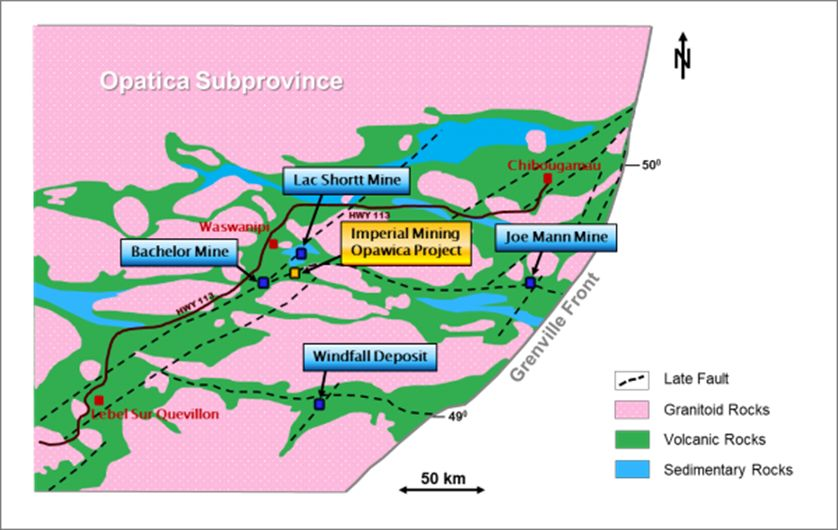Jan 8 2020
Imperial Mining Group Ltd., a Canadian mineral exploration and development company, is happy to announce that the geological and geophysical data compilation meant for the Opawica Gold project has been finalized. The data compilation has also recognized crucial gold targets for a 1500-m diamond drilling program during the winter period in 2020.
 Opawica Gold Project, location map, Quebec. Image Credit: Imperial Mining Group Ltd.
Opawica Gold Project, location map, Quebec. Image Credit: Imperial Mining Group Ltd.
The drilling program aims to follow up on historical drilling areas from the Central Zone target region that returned up to 87.7 g/t gold (Au) over 1.5 m and 6.9 g/t Au over 3.8 m. To date, the Central Zone target area has yet to be tested for drilling below a vertical level of 125 m, remaining exposed along strike and in-depth.
Situated 20 km east of Desmaraisville, the fully owned gold property can be accessed through Highway 113 from Val d’Or to Chibougamau in Quebec, and also through a network of forestry roads.
Ground Magnetic Geophysical Survey
During the 2019 Fall period, a GPS-positioned ground magnetic survey was concluded on the property across the grid, whereby the OreVision™ Induced Polarization (IP) survey was earlier performed by Abitibi Geophysics. This latest ground magnetic survey was again carried out by Abitibi Geophysics of Val d’Or, Quebec. In total, 68 km was finished by a two-man team on October 20th, 2019.
The survey results offer a more accurate definition of the gold-bearing structures present on the property. The North East-trending deformation corridor can be tracked for more than 2.2 km, with two highly magnetic features being identified inside this corridor.
Based on the magnetometer data, magnetic lows were discovered in the eastern and western parts of the study grid and are understood to be associated with gold mineralization alteration zones. Impressively, within the North East-trending deformation corridor, a few of these interpreted magnetic features corresponded with a highly anomalous IP axis comprehended from the earlier OreVision™ IP survey.
3D Geological Model
Geologica Group Conseil of Val d’Or, Quebec, completed the 3D geological model in November 2019. The entire historic boreholes were compiled, focusing on the modeling of the gold-related sulfide mineralization, quartz-carbonate veins, and the numerous types of alteration zones elucidated in the historical drill-hole records.
The 3D geological model targeted on the Central Gold Zone, defined in historical drilling as a deformation and alteration corridor measuring 75–150 m in width and containing numerous shear zones with robust and pervasive sericite, carbonate, and fuchsite alteration. The mineralization is defined as fine-grained disseminated quartz and pyrite veinlets with silver, gold, and sometimes visible gold (VG).
The outcomes of this latest model demonstrate that the quartz veins, veinlets, and mineralization may have a shallower dip to the north than previously interpreted.
The 3D geological model was created by machine learning methods; taking alteration intensity, presence of anomalous gold, structure, and favorable geology into consideration. The study helped to identify two major target regions in a “Heat Map”: the latest target region located to the west, the known “Central Gold Zone”, and the “New West Zone.”
Winter 2020 Diamond Drill Program
In early January 2020, Imperial Mining Group has planned to begin a 1500-m diamond drill program. Orbite Garant of Val d’Or, Quebec, will serve as the drilling contractor. The entire analytical work will be conducted by AGAT Laboratories, also from Val d’Or, Quebec. During this drilling phase, 4 to 6 diamond drill holes will be completed.
Drilling will be performed on the two regions identified from the modeling efforts of the Imperial Mining Group. By utilizing an automatic predictive technique called CET Grid Analysis, the targets were also outlined.
The predictive technique emphasizes high, gold-favorable structural complexity zones utilizing lineaments that are automatically mapped within the entire magnetic field reduced to pole and also highlights favorable geochemistry and geology. The program is expected to be finished by mid-February 2020.